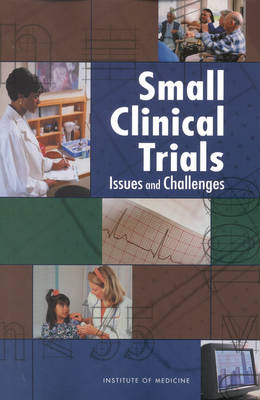
Small Clinical Trials
Issues and Challenges
Seiten
2001
National Academies Press (Verlag)
978-0-309-07333-2 (ISBN)
National Academies Press (Verlag)
978-0-309-07333-2 (ISBN)
- Keine Verlagsinformationen verfügbar
- Artikel merken
Clinical trials are used to elucidate the most appropriate preventive, diagnostic, or treatment options for individuals with a given medical condition. This title assesses the methodologies and the appropriate situations for the conduct of clinical trials with small sample sizes.
Clinical trials are used to elucidate the most appropriate preventive, diagnostic, or treatment options for individuals with a given medical condition. Perhaps the most essential feature of a clinical trial is that it aims to use results based on a limited sample of research participants to see if the intervention is safe and effective or if it is comparable to a comparison treatment. Sample size is a crucial component of any clinical trial. A trial with a small number of research participants is more prone to variability and carries a considerable risk of failing to demonstrate the effectiveness of a given intervention when one really is present. This may occur in phase I (safety and pharmacologic profiles), II (pilot efficacy evaluation), and III (extensive assessment of safety and efficacy) trials. Although phase I and II studies may have smaller sample sizes, they usually have adequate statistical power, which is the committee's definition of a "large" trial. Sometimes a trial with eight participants may have adequate statistical power, statistical power being the probability of rejecting the null hypothesis when the hypothesis is false.
Small Clinical Trials assesses the current methodologies and the appropriate situations for the conduct of clinical trials with small sample sizes. This report assesses the published literature on various strategies such as (1) meta-analysis to combine disparate information from several studies including Bayesian techniques as in the confidence profile method and (2) other alternatives such as assessing therapeutic results in a single treated population (e.g., astronauts) by sequentially measuring whether the intervention is falling above or below a preestablished probability outcome range and meeting predesigned specifications as opposed to incremental improvement.
Table of Contents
Front Matter
Executive Summary
1 Introduction
2 Design of Small Clinical Trials
3 Statistical Approaches to Analysis of Small Clinical Trials
4 General Guidelines
References
Appendix A Study Methods
Appendix B Glossary of Statistical and Clinical Trials Terms
Appendix C Selected Bibliography on Small Clinical Trials
Appendix D Committee and Staff Biographies
Clinical trials are used to elucidate the most appropriate preventive, diagnostic, or treatment options for individuals with a given medical condition. Perhaps the most essential feature of a clinical trial is that it aims to use results based on a limited sample of research participants to see if the intervention is safe and effective or if it is comparable to a comparison treatment. Sample size is a crucial component of any clinical trial. A trial with a small number of research participants is more prone to variability and carries a considerable risk of failing to demonstrate the effectiveness of a given intervention when one really is present. This may occur in phase I (safety and pharmacologic profiles), II (pilot efficacy evaluation), and III (extensive assessment of safety and efficacy) trials. Although phase I and II studies may have smaller sample sizes, they usually have adequate statistical power, which is the committee's definition of a "large" trial. Sometimes a trial with eight participants may have adequate statistical power, statistical power being the probability of rejecting the null hypothesis when the hypothesis is false.
Small Clinical Trials assesses the current methodologies and the appropriate situations for the conduct of clinical trials with small sample sizes. This report assesses the published literature on various strategies such as (1) meta-analysis to combine disparate information from several studies including Bayesian techniques as in the confidence profile method and (2) other alternatives such as assessing therapeutic results in a single treated population (e.g., astronauts) by sequentially measuring whether the intervention is falling above or below a preestablished probability outcome range and meeting predesigned specifications as opposed to incremental improvement.
Table of Contents
Front Matter
Executive Summary
1 Introduction
2 Design of Small Clinical Trials
3 Statistical Approaches to Analysis of Small Clinical Trials
4 General Guidelines
References
Appendix A Study Methods
Appendix B Glossary of Statistical and Clinical Trials Terms
Appendix C Selected Bibliography on Small Clinical Trials
Appendix D Committee and Staff Biographies
Committee on Strategies for Small-Number-Participant Clinical Research Trials, Board on Health Sciences Policy
1 Front Matter; 2 Executive Summary; 3 1 Introduction; 4 2 Design of Small Clinical Trials; 5 3 Statistical Approaches to Analysis of Small Clinical Trials; 6 4 General Guidelines; 7 References; 8 Appendix A Study Methods; 9 Appendix B Glossary of Statistical and Clinical Trials Terms; 10 Appendix C Selected Bibliography on Small Clinical Trials; 11 Appendix D Committee and Staff Biographies
| Erscheint lt. Verlag | 1.2.2001 |
|---|---|
| Verlagsort | Washington |
| Sprache | englisch |
| Maße | 152 x 229 mm |
| Themenwelt | Schulbuch / Wörterbuch ► Lexikon / Chroniken |
| Medizin / Pharmazie ► Gesundheitsfachberufe ► Diätassistenz / Ernährungsberatung | |
| ISBN-10 | 0-309-07333-2 / 0309073332 |
| ISBN-13 | 978-0-309-07333-2 / 9780309073332 |
| Zustand | Neuware |
| Haben Sie eine Frage zum Produkt? |
Mehr entdecken
aus dem Bereich
aus dem Bereich
Indikation, Diagnostik, Therapie
Buch (2024)
Thieme (Verlag)
80,00 €
Unter Mitarbeit von Walter Burghardt
Buch | Softcover (2020)
Urban & Fischer in Elsevier (Verlag)
56,00 €


